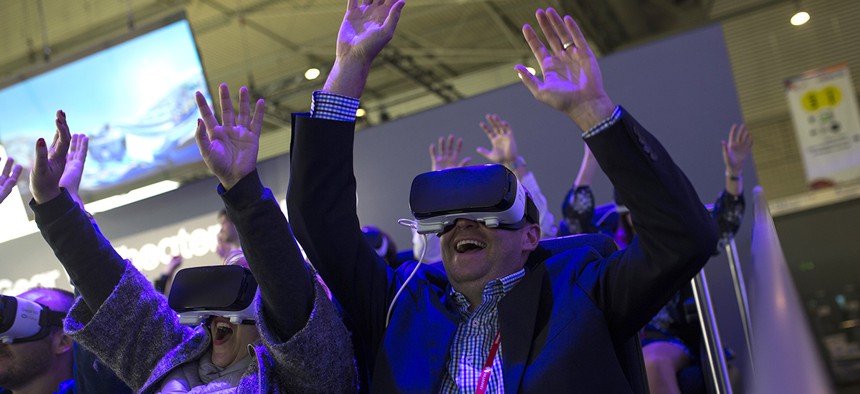The New Social Network Where You Can Hang Out with Real People in Virtual Reality

People react as they use the new Samsung Gear 360, a 360-degree camera, during the Mobile World Congress Wireless show in Barcelona, Spain, Wednesday, Feb. 24, 2016. Francisco Seco/AP
Instead of hanging out with your friends in real life, why not spend time with them in outer space?
Instead of hanging out with your friends in real life, why not spend time with them in outer space?
vTime, the first virtual reality social network, wants to make that possible. Developed by Starship Group, a VR/AR innovation company, the service launched on Google Cardboard on March 11 and the app works on the Samsung Gear VR too.
The social network lets you create a virtual avatar and interact with other 1-3 other users in 12 different virtual worlds. You can create chatrooms and invite your friends, or have the system randomly pair you with a user to talk to-called Random Match. The company told Quartz it has “tens of thousands of users in 150 countries.”
An early review for vTime praised the app for creating complex and detailed virtual worlds, but pointed out a problem: You can’t really do anything in these worlds besides sit and talk to people. Still, the app hints at the power of virtual reality: It can enhance our lives and add new experiences to our everyday life.
“The key problem we wanted to solve with vTime was a shared experience. We want to focus on communication and find a new and unique way to communicate in VR,” Starship’s Managing Director Clemens Wangerin told Quartz in a phone interview.
As virtual reality becomes more prevalent in our lives, developers are flocking to the new medium. The interest is warranted—Goldman Sachs projecting virtual and augmented reality can become an $80 billion business by 2025. Tech giants like Facebook, Samsung and HTC are already working on virtual reality headsets scheduled for release later this year. Google and Apple are reportedly interested in making forays into virtual reality as well.
Wangerin said to expect new features and enhancements over time. “Everything that’s there will only get better and more of it—more destinations and better audio, for instance.” The company is thinking about adding file and photo sharing for users—content that’s already on your phone can be sent to the virtual worlds inside vTime. Starship is also exploring video sharing capability.
“There’s lots of interest in the commercial side,” Wangerin said. For instance, theoretically, vTime could be used to “have a session with your doctor about treatment and it feels different because it’s in that shared space.”
Starship plans to develop versions of vTime for every virtual reality headset, including the Oculus Rift, HTC Vive, and Playstation VR, Wangerin told Quartz. If you don’t have a virtual reality headset, if can still work for you—vLife works with smartphones like the Nexus 6 and LG G3 as well.


